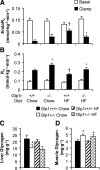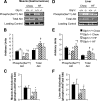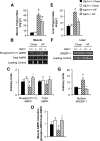Glucagon-like peptide-1 receptor knockout mice are protected from high-fat diet-induced insulin resistance
- PMID: 20685876
- PMCID: PMC2946144
- DOI: 10.1210/en.2010-0289
Glucagon-like peptide-1 receptor knockout mice are protected from high-fat diet-induced insulin resistance
Abstract
Glucagon-like peptide-1 augments nutrient-stimulated insulin secretion. Chow-fed mice lacking the glucagon-like peptide-1 receptor (Glp1r) exhibit enhanced insulin-stimulated muscle glucose uptake but impaired suppression of endogenous glucose appearance (endoRa). This proposes a novel role for the Glp1r to regulate the balance of glucose disposal in muscle and liver by modulating insulin action. Whether this is maintained in an insulin-resistant state is unknown. The present studies tested the hypothesis that disruption of Glp1r expression overcomes high-fat (HF) diet-induced muscle insulin resistance and exacerbates HF diet-induced hepatic insulin resistance. Mice with a functional disruption of the Glp1r (Glp1r-/-) were compared with wild-type littermates (Glp1r+/+) after 12 wk on a regular chow diet or a HF diet. Arterial and venous catheters were implanted for sampling and infusions. Hyperinsulinemic-euglycemic clamps were performed on weight-matched male mice. [3-(3)H]glucose was used to determine glucose turnover, and 2[14C]deoxyglucose was used to measure the glucose metabolic index, an indicator of glucose uptake. Glp1r-/- mice exhibited increased glucose disappearance and muscle glucose metabolic index on either diet. This was associated with enhanced activation of muscle Akt and AMP-activated protein kinase and reduced muscle triglycerides in HF-fed Glp1r-/- mice. Chow-fed Glp1r-/- mice exhibited impaired suppression of endoRa and hepatic insulin signaling. In contrast, HF-fed Glp1r-/- mice exhibited improved suppression of endoRa and hepatic Akt activation. This was associated with decreased hepatic triglycerides and impaired activation of sterol regulatory element-binding protein-1. These results show that mice lacking the Glp1r are protected from HF diet-induced muscle and hepatic insulin resistance independent of effects on total fat mass.
Figures






Similar articles
-
The glucagon-like peptide-1 receptor regulates endogenous glucose production and muscle glucose uptake independent of its incretin action.Endocrinology. 2009 Mar;150(3):1155-64. doi: 10.1210/en.2008-0945. Epub 2008 Nov 13. Endocrinology. 2009. PMID: 19008308 Free PMC article.
-
Acute activation of central GLP-1 receptors enhances hepatic insulin action and insulin secretion in high-fat-fed, insulin resistant mice.Am J Physiol Endocrinol Metab. 2012 Feb 1;302(3):E334-43. doi: 10.1152/ajpendo.00409.2011. Epub 2011 Nov 15. Am J Physiol Endocrinol Metab. 2012. PMID: 22094469
-
Insulin action in the double incretin receptor knockout mouse.Diabetes. 2008 Feb;57(2):288-97. doi: 10.2337/db07-0704. Epub 2007 Oct 31. Diabetes. 2008. PMID: 17977951
-
Regulation of glucose kinetics during exercise by the glucagon-like peptide-1 receptor.J Physiol. 2012 Oct 15;590(20):5245-55. doi: 10.1113/jphysiol.2012.234914. Epub 2012 Aug 13. J Physiol. 2012. PMID: 22890715 Free PMC article.
-
Unraveling oxyntomodulin, GLP1's enigmatic brother.J Endocrinol. 2012 Dec;215(3):335-46. doi: 10.1530/JOE-12-0368. Epub 2012 Sep 27. J Endocrinol. 2012. PMID: 23019069 Free PMC article. Review.
Cited by
-
Poly-Agonist Pharmacotherapies for Metabolic Diseases: Hopes and New Challenges.Drugs. 2024 Feb;84(2):127-148. doi: 10.1007/s40265-023-01982-6. Epub 2023 Dec 21. Drugs. 2024. PMID: 38127286 Review.
-
Medial hypothalamic MC3R signalling regulates energy rheostasis in adult mice.J Physiol. 2025 Jan;603(2):379-410. doi: 10.1113/JP286699. Epub 2024 Dec 24. J Physiol. 2025. PMID: 39718394 Free PMC article.
-
Sleeve Gastrectomy Improves High-Fat Diet-Associated Hepatic Steatosis Independent of the Glucagon-like-Petpide-1 Receptor in Rats.J Gastrointest Surg. 2022 Aug;26(8):1607-1618. doi: 10.1007/s11605-022-05361-6. Epub 2022 May 26. J Gastrointest Surg. 2022. PMID: 35618993 Free PMC article.
-
G-Protein-Coupled Receptor (GPCR) Signaling and Pharmacology in Metabolism: Physiology, Mechanisms, and Therapeutic Potential.Biomolecules. 2025 Feb 15;15(2):291. doi: 10.3390/biom15020291. Biomolecules. 2025. PMID: 40001594 Free PMC article. Review.
-
Novel candidate colorectal cancer biomarkers identified by methylation microarray-based scanning.Endocr Relat Cancer. 2011 Jul 4;18(4):465-78. doi: 10.1530/ERC-11-0083. Print 2011 Aug. Endocr Relat Cancer. 2011. PMID: 21636702 Free PMC article.
References
-
- Campos RV, Lee YC, Drucker DJ 1994 Divergent tissue-specific and developmental expression of receptors for glucagon and glucagon-like peptide-1 in the mouse. Endocrinology 134:2156–2164 - PubMed
-
- Bullock BP, Heller RS, Habener JF 1996 Tissue distribution of messenger ribonucleic acid encoding the rat glucagon-like peptide-1 receptor. Endocrinology 137:2968–2978 - PubMed
-
- Miyawaki K, Yamada Y, Yano H, Niwa H, Ban N, Ihara Y, Kubota A, Fujimoto S, Kajikawa M, Kuroe A, Tsuda K, Hashimoto H, Yamashita T, Jomori T, Tashiro F, Miyazaki J, Seino Y 1999 Glucose intolerance caused by a defect in the entero-insular axis: a study in gastric inhibitory polypeptide receptor knockout mice. Proc Natl Acad Sci USA 96:14843–14847 - PMC - PubMed
-
- Komatsu R, Matsuyama T, Namba M, Watanabe N, Itoh H, Kono N, Tarui S 1989 Glucagonostatic and insulinotropic action of glucagonlike peptide I-(7–36)-amide. Diabetes 38:902–905 - PubMed
Publication types
MeSH terms
Substances
Grants and funding
LinkOut - more resources
Full Text Sources
Medical
Molecular Biology Databases
Research Materials
Miscellaneous

